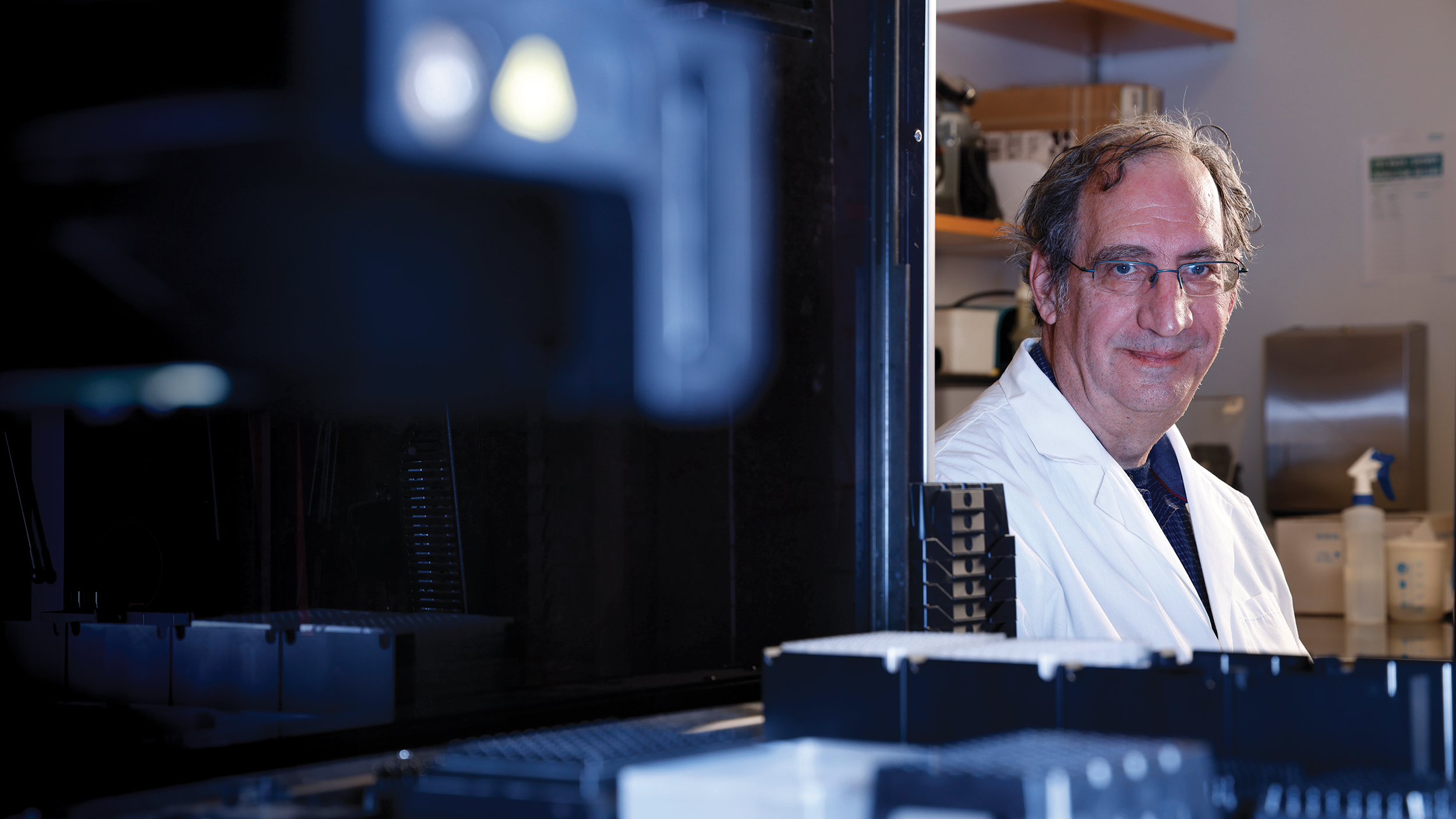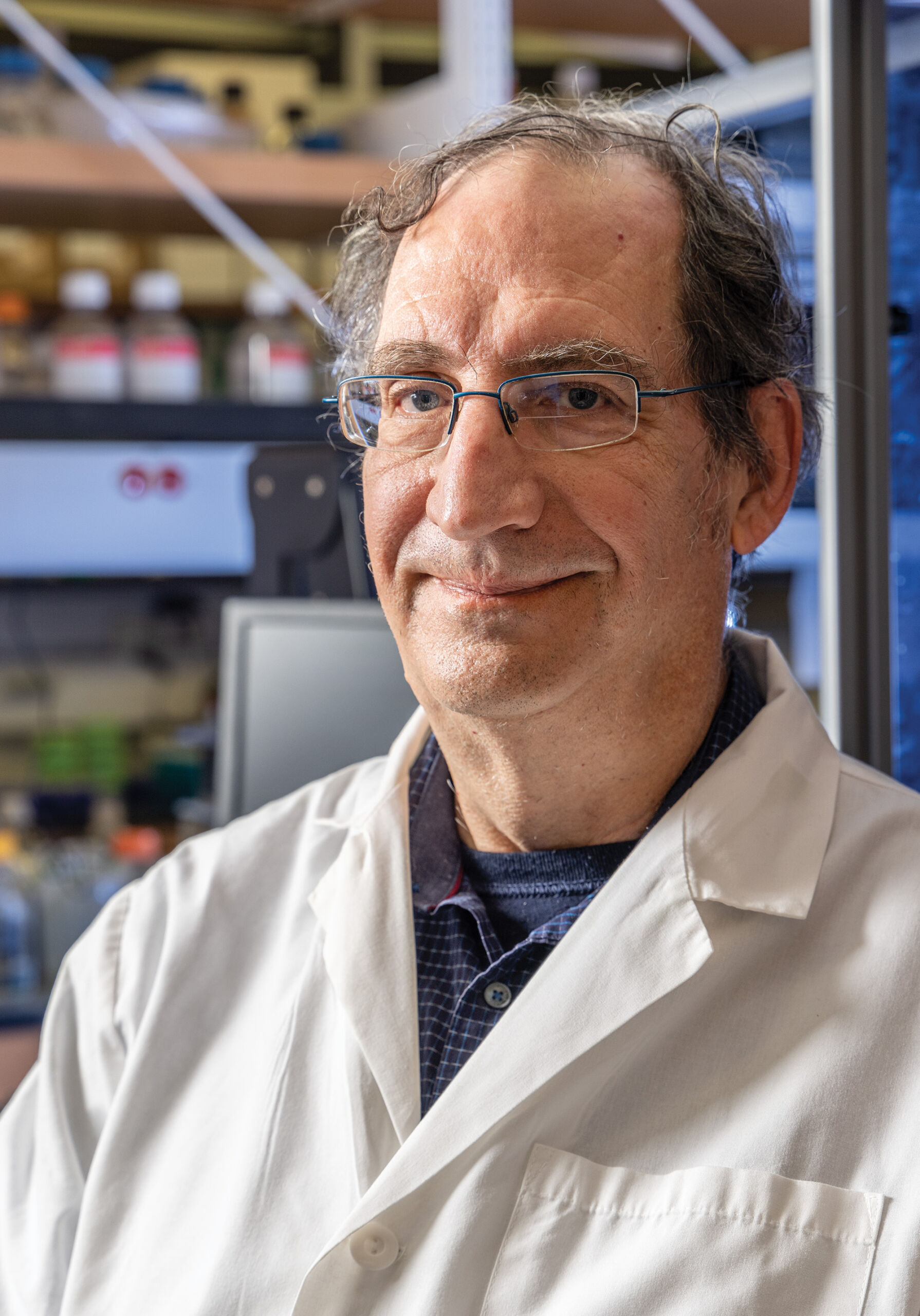The Receptor Scientist
Posted on Jan. 21, 2022
(Grant Halverson ’93)
Bryan Roth wants to turn psychedelic drugs into a pill to treat depression without side effects. The Feds gave him $26.9 million to see whether he can do it.
by Mark Derewicz
The teenage Bryan Roth in 1968 knew of a friend who dropped acid multiple times and landed in a mental institution. Other friends spoke of life-altering, consciousness-expanding experiences while on lysergic acid diethylamide and psilocybin (the active ingredient in hallucinogenic “magic mushrooms”). Roth, a Buddhist since age 17, never cared to take drugs; he preferred meditation, which he said turned his life around: “I had been pretty much turned off from school, and for reasons not entirely clear to me, after meditating regularly, I began to take high school seriously.”
A couple years later, as an undergrad at Carroll College in Montana, he sat rapt as a guest lecturer explained how drugs, including LSD, fit into these theoretical things called receptors on the surface of brain cells, triggering such profound chemical reactions inside cells that Brave New World author Aldous Huxley and The Doors’ lead vocalist Jim Morrison would say that for them, psychedelics opened the doors of perception.
Roth was hooked … on receptors.
“I needed to know how all this worked,” said Roth, the Michael Hooker ’69 Distinguished Professor of pharmacology in the School of Medicine. “We needed to know what these receptors looked like to create better therapeutics. It became my life mission.”
Why so serious?
The problem with so many therapeutics is they carpet bomb various cell types and affect many receptors. They cause intended effects, such as pain relief, but also side effects, such as your brain telling your lungs to stop working, which is what happens with fentanyl overdoses.
“What if we could create a drug that only latches onto the receptor we know is important for chronic pain or depression or schizophrenia?” Roth asks. That would be amazing, but that isn’t the only hurdle.
When a drug enters a cell, it triggers a cascade of proteins to improve symptoms of, say, depression. But inside that same cell, the drug can trigger another pathway that causes stomach problems or tiredness or brain fog or dizziness or low sex drive. Creating an effective drug without nasty side effects is considered a holy grail.
In graduate school at St. Louis University, Roth and others thought once you learned the exact amino acid structure of a receptor, you could create a compound to bind only to that specific receptor in a precise way to trigger the right protein pathway. Easy to think, hard to do.
Meanwhile, depression rates in the United States, especially among military members, skyrocketed. Drug developers created a slew of therapeutics, all of which have a litany of side effects. But there was one they didn’t consider much.
LSD was discovered in the 1930s and researched for antidepressant properties in the 1950s and ’60s. Then, as happens with LSD, things went sideways. The CIA used it in mind-control experiments. Timothy Leary popularized LSD in the mid ’60s, advising people to turn on, tune in and drop out. And in 1969, LSD left a bad taste in everyone’s mouth when Los Angeles prosecutors revealed its central role in the derangement of Charles Manson and his murderous cult followers. The government shut down research and deemed LSD and psilocybin controlled substances in 1971.
LSD was discovered in the 1930s and researched for antidepressant properties in the 1950s and ’60s. Then, as happens with LSD, things went sideways.
In the 1990s, research on LSD slowly emerged from its checkered past. Since then, LSD and psilocybin have been used to impressive effect in small clinical studies of depression and alcoholism.
“Psilocybin has the most robust antidepressant effect I’ve ever seen in Phase II trials,” said Roth, a trained psychiatrist who saw patients for decades before coming to Carolina. An hours-long, guided hallucinogenic trip to treat a psychiatric condition or addiction could work for some people, but Roth said that’s not a viable path for the millions suffering from alcoholism, depression, schizophrenia and related conditions such as severe anxiety.
There is only one research project grant from the National Institutes of Health to study LSD. Roth leads it. And last year, the Defense Advanced Research Project Agency awarded Roth and his handpicked international experts $26.9 million to push his research toward a finish line.
“DARPA funds high-risk, high-reward projects,” Roth said. “Basically, they want us to create a pill that cures depression without psychedelic trips or other side effects. We don’t know if this is possible. But they want to find out, and so do we.”
The crystal ship
Roth’s lab and others spent the past three decades trying to solve the three-dimensional, dynamic structure of compounds bound to receptors, which are the intended targets for about 30 percent of pharmaceuticals on the market.
“We tried everything we could think of, but in the end, the technology simply didn’t exist.”
Roth reflected on his career in the mid-2000s and decided a change was in order. Carolina recruited him in 2006 to focus on basic science.
“There have been no boundaries here. If I needed more lab space, they’d say, ‘You bring in grants and hire people, we’ll keep getting you more space.’ I can tell you this is not the case everywhere.”
Roth’s production has been undeniable. He leads the multimillion-dollar National Institute of Mental Health’s Psychotropic Drug Screening Program. He co-leads a $14 million NIH grant titled Illuminating the Druggable Genome.
His lab has engineered receptors to study the chemical structures of all known drugs and their binding sites on human cells. This technology, called Designer Receptors Exclusively Activated by Designer Drugs, helps scientists predict what kinds of drugs might work best for various health conditions. He is a sought-after lecturer and a member of the American Academy of Arts and Sciences.
Since coming to Carolina, Roth’s Buddhist practice has led him to the Chapel Hill Zen Center, where he meditates almost daily. “My practice has been lifesaving for me,” he said. “Clearly, regular meditation has all sorts of practical benefits — improved concentration, decreased stress and so on. But for me, it has been more a salvation than a panacea. Without it, I never would have had any success in either life or science.”

Bryan Roth: “Clearly, regular meditation has all sorts of practical benefits — improved concentration, decreased stress and so on. But for me, it has been more a salvation than a panacea. Without it, I never would have had any success in either life or science.” (Vgorbash/iStock)
In terms of science, Roth sees a couple of lessons from Zen meditation. “The first is to expect the unexpected,” he said. “This is a typical exhortation during Zen meditation retreats and informs most of my research, which is more discovery-oriented than hypothesis testing. Another, more recent lesson, has been to embrace ‘not knowing.’ That is, when questioned about some puzzling thing, I am more apt to say, ‘Wow, that is really interesting; I don’t really know.’ And then we ponder how best to address this perplexity.”
Roth’s career has been a complete success by all standards. Yet until recently, a white whale remained: solving the 3D crystal structure of a hallucinogenic drug bound in its active state to a HTR2A serotonin receptor. That is, discovering exactly what the main serotonin receptor looks like when someone is tripping on LSD or magic mushrooms. Key word is crystal. Without crystals — a perfect, static, high-resolution structure — no one would be able to study and manipulate the exact chemical structure of the receptor. And without that, no one could create a less hallucinogenic version with antidepressant powers. The same goes for creating a better opioid or an antipsychotic.
“To get crystals of a known compound bound to its receptor is incredibly difficult,” Roth said, “in some cases, nearly impossible.”
In 2014, with a new strategy in hand, Roth put postdoctoral researchers Daniel Wacker, John McCorvy, Sheng Wang and Kuglae Kim on the project. While a graduate student at Scripps Institute, Wacker was the first scientist to solve the crystal structure of a serotonin receptor by itself. Wacker explains the initial bench work:
To create a crystal image, scientists need a lot of receptors, which are much smaller than the wavelength of visible light. So they need to use X-rays to see what receptors look like. For that to work, they need all the receptors to sit perfectly still in the same exact way — and that’s what happens in crystals.
But serotonin receptors don’t sit still. They twitch and change shape so the cells can perform a function. In the case of magic mushrooms, that function is hallucinations and alterations in perception and mood. But this shape shifting makes it nearly impossible to create an image of the drug bound to a receptor.
“So we need to dissolve all these receptors in water and then slowly take away the water,” Wacker said. “The temperature needs to be just right. And then we need to employ all kinds of experimental tricks to further draw out the water and coax the molecules to sit still so they will have to crystallize.”
It’s sort of like letting soup sit out overnight, he said. The next morning, you’ll notice salt crystals at the bottom. That’s because as the water in the soup slowly evaoprated, the soup’s salt molecules latched onto each other to remain stable. The result: crystals.
But serotonin receptors are not soup. It took two years for Wacker and Wang to get serotonin-LSD crystals packed together, a feat that allowed them to shoot X-rays at the receptors in order to create images at atomic resolution. It was the first time scientists had the full chemical structure of LSD bound to a serotonin receptor, specifically the HTR2B receptor, which is involved in side effects. But they couldn’t solve the structure of the HTR2A receptor, which is key to hallucinations and probably therapeutic effects. And they couldn’t figure out what the tiny proteins between LSD and the HTR2B structure looked like.
These tiny proteins, called transducer molecules, are crucial during the binding of a drug to a receptor. Together the LSD, HTR2A and transducer proteins make a complex. That’s what Roth wanted to figure out.
Still, Roth did find something interesting while studying HTR2B. As LSD latched onto the cell, the receptor proteins formed a kind of lid over the drug. McCorvy discovered that the lid kept LSD bound to HTR2B for a long time.

There is only one research project grant from the National Institutes of Health to study LSD. Roth leads it. And last year, the Defense Advanced Research Project Agency awarded Roth and his handpicked international experts $26.9 million to push his research toward a finish line. (Grant Halverson ’93)
“This could be why acid trips last so long,” Roth said. “Typically, drugs wash out of neurons much faster.”
They published this work in the preeminent journal Cell in 2017.
Slew of receptors
During the same time, Roth’s lab and colleagues solved the structure of the kappa opioid receptor, which is critical information for building better opioid medications. They solved the structure of melatonin receptors, which are important in sleep disorders, diabetes and some cancers. And his lab solved the structure of the dopamine 2 receptor, which is important for treatment of bipolar disorder, schizophrenia and other conditions.
Still, Roth’s white whale remained — the HTR2A serotonin receptor bound to an active psychotropic. This time, Kim explored various experimental methods to purify and stabilize the very delicate serotonin receptors.
“Ku was amazing,” Roth said. “I’m not exaggerating when I say what he accomplished is among the most difficult things to do in science. Over three years in a deliberate, iterative, creative process, he was able to modify the serotonin protein slightly so that we could get sufficient quantities of a stable protein to study.”
In 2020, Roth used Kim’s work to reveal the first X-ray crystal structure of LSD bound to HTR2A. Stanford University colleagues then used a fancy kind of electron microscope to create images of a hallucinogen attached to the entire receptor complex, which controls the release of brain chemicals that influence many biological and brain processes.
That image is like a map of the complex, which Kim then used to illustrate the exact structure of HTR2A at the level of amino acids.
“This is the most excited I’ve ever been in my career,” Roth said. “This is a really big thing. My desire to find out what this receptor was and what it looked like — how it caused such incredible effects — is what got me started in science.”
But he’s not finished.
“We still have work to do. Some people think it’s impossible to separate the hallucinogenic effects from antidepressant effects. Maybe. We don’t know, but we have reasons to believe that’s not the case.
“We know psilocybin interacts strongly with other receptors in ways that are likely not beneficial. And we can likely get rid of these effects. In fact, we already have compounds that can do this.”
But that story, funded by DARPA, is not yet ready to be told. Tune in later, and expect the unexpected.
Mark Derewicz is director of research news for UNC Health and a freelance writer living in Chatham County.
Thanks for reading the Carolina Alumni Review
Carolina Alumni members, sign in to continue reading.
Not yet a member? Become one today.
